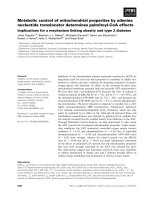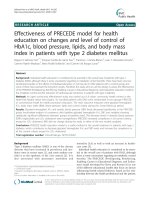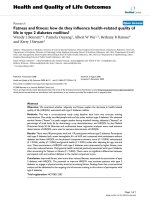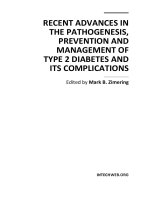Common genetic variation in nephrin (NPHS1) and its associations with renal and type 2 diabetes mellitus related traits
Bạn đang xem bản rút gọn của tài liệu. Xem và tải ngay bản đầy đủ của tài liệu tại đây (1.79 MB, 97 trang )
COMMON GENETIC VARIATION IN NEPHRIN (NPHS1)
AND ITS ASSOCIATIONS WITH RENAL AND
TYPE 2 DIABETES MELLITUS-RELATED TRAITS
LIN BITONG CLARABELLE ALEXANDRINE
(B.Sc. Hons.), NUS
A THESIS SUBMITTED
FOR THE DEGREE OF MASTER OF SCIENCE
SAW SWEE HOCK SCHOOL OF PUBLIC HEALTH
(Formerly Department of Community, Occupational and Family Medicine,
Yong Loo Lin School of Medicine)
NATIONAL UNIVERSITY OF SINGAPORE
2012
For MUM and Aaron
Love, Belle
DECLARATION
i
ACKNOWLEDGEMENTS
I would like to express my deepest appreciation to my supervisor Dr. Daniel Ng for all
his wisdom, direction and support throughout the course of my study. I am also grateful
to Dr. Agus Salim for his guidance and patience on my statistical queries.
Much thanks and appreciation goes to members of the Disease Genetics Laboratory, Ms
Siti Nurbaya Ramli and Ms Lim Xiu Li, for their generous assistance and lovely
company. I am also thankful for the numerous other staff and graduate students who have
encouraged and accompanied me on this journey.
I would like to express my deepest gratitude to my family and loved ones for their
endless love and support in all that I do.
Last but not least, I would like to give glory to God and Mother Mary for making this
possible.
ii
TABLE OF CONTENTS
DECLARATION ................................................................................................................. i
ACKNOWLEDGEMENTS ................................................................................................ ii
SUMMARY ....................................................................................................................... vi
LIST OF TABLES ............................................................................................................ vii
LIST OF FIGURES ........................................................................................................... ix
LIST OF SUPPLEMENTARY TABLES .......................................................................... xi
LIST OF ABBREVIATIONS ........................................................................................... xii
CHAPTER ONE: INTRODUCTION ................................................................................. 1
1.1
Type 2 diabetes mellitus (T2DM) ........................................................................ 1
1.1.1
T2DM and its complications ......................................................................... 1
1.1.2
Prevalence of T2DM ..................................................................................... 1
1.1.3
T2DM-related traits and undiagnosed diabetes ............................................ 2
1.2
Diabetic nephropathy (DN) .................................................................................. 3
1.2.1
Clinical pathology of DN .............................................................................. 4
1.2.2
Renal trait - GFR ........................................................................................... 6
1.2.3
Urinary marker of DN - albumin .................................................................. 7
1.2.4
Glomerular filtration barrier ......................................................................... 9
1.2.5
Genetics of DN ........................................................................................... 12
1.3
NPHS1 gene ....................................................................................................... 13
1.3.1
Congenital nephrotic syndrome of the Finnish type ................................... 13
1.3.2
Experimental models .................................................................................. 13
1.3.3
Discovery of the NPHS1 gene .................................................................... 15
1.3.4
Structure of the NPHS1 gene ...................................................................... 15
1.3.5
NPHS1 structure ......................................................................................... 15
1.3.6
Impact of mutations on NPHS1 function .................................................... 17
1.3.7
Primary and extrarenal NPHS1 expression................................................. 17
iii
1.4
DN and NPHS1 .................................................................................................. 19
1.4.1
In vitro studies............................................................................................. 19
1.4.2
Experimental models .................................................................................. 19
1.4.3
NPHS1 in kidneys of diabetic patients ....................................................... 19
1.4.4
Nephrinuria ................................................................................................. 20
1.4.5
NPHS1 variants and DN ............................................................................. 21
1.5
T2DM and NPHS1 ............................................................................................. 22
1.5.1
In vitro studies............................................................................................. 22
1.5.2
Experimental models .................................................................................. 22
1.5.3
NPHS1 in pancreatic islets of diabetic patients .......................................... 23
1.5.4
NPHS1 and insulin resistance in humans ................................................... 23
1.5.5
NPHS1 variants with T2DM and T2DM-related traits ............................... 23
1.6
Summary and rationale for present work ........................................................... 24
1.6.1
NPHS1 and DN ........................................................................................... 24
1.6.2
NPHS1 and T2DM ...................................................................................... 25
1.6.3
Aims of study .............................................................................................. 26
CHAPTER 2: MATERIALS AND METHODS .............................................................. 27
2.1
Patient populations ............................................................................................. 27
2.1.1
Singapore Diabetes Cohort Study (SDCS) ................................................. 27
2.1.2
1998 Singapore National Health Survey (NHS98) ..................................... 27
2.1.3
Laboratory methods .................................................................................... 28
2.1.4
Selection of NPHS1 SNPs .......................................................................... 31
2.1.5
Genotyping .................................................................................................. 33
2.1.6
Statistical analysis ....................................................................................... 34
CHAPTER 3: RESULTS .................................................................................................. 37
3.1
Aim 1 .................................................................................................................. 37
iv
3.1.1
Clinical characteristics of SDCS subjects ................................................... 37
3.1.2
HWE and LD of NPHS1 SNPs in SDCS subjects ...................................... 39
3.1.3
NPHS1 and albuminuria ............................................................................. 40
3.1.4
NPHS1 and eGFR ....................................................................................... 46
3.2
AIM 2 ................................................................................................................. 51
3.2.1
Clinical Characteristics of NHS98 subjects ................................................ 51
3.2.2
HWE and LD of NPHS1 SNPs in NHS98 subjects .................................... 53
3.2.3
NPHS1 and T2DM-related traits ................................................................ 53
3.3
AIM 3 ................................................................................................................. 55
3.3.1
Clinical characteristics of Chinese SDCS and NHS98 subjects ................. 55
3.3.2
HWE of NPHS1 SNPs in Chinese SDCS and NHS98 subjects ................. 57
3.3.3
NPHS1 and glucose tolerance status in Chinese......................................... 57
CHAPTER 4: DISCUSSION ............................................................................................ 60
4.1
Discussion of results........................................................................................... 60
4.2
Further studies .................................................................................................... 63
4.2.1
Follow-up studies ........................................................................................ 63
4.2.2
Candidate genes .......................................................................................... 63
4.3
Conclusion.......................................................................................................... 64
BIBLIOGRAPHY ............................................................................................................. 65
APPENDICES .................................................................................................................. 74
v
SUMMARY
Nephrin (NPHS1) is a key structural component of the slit diaphragm (SD) and common
genetic variation of NPHS1 may influence SD function in diabetic nephropathy (DN).
More recently, NPHS1 has also been reported in pancreatic β-cells and was involved in
insulin secretion. Thus, common genetic variation of NPHS1 may be associated with type
2 diabetes mellitus (T2DM) and its related traits. However, there are currently few
studies investigating these potential roles of NPHS1. Therefore, this study investigated
the association of NPHS1with both renal and T2DM-related traits. Six NPHS1 SNPs
were genotyped in both the Singapore Diabetes Cohort Study and 1998 Singapore
National Health Survey subjects. There was significant evidence for interaction of
NPHS1 haplotypes with age on estimated glomerular filtration rate (eGFR) in T2DM
patients. Specifically, with reference to the common haplotype, carriers of T/G/G/C/T/A
and C/A/A/T/T/A had higher eGFR values among younger patients but had lower eGFR
values among older patients. In contrast, carriers of T/G/A/T/T/G had lower eGFR values
among younger patients with reference to the common haplotype. NPHS1 was generally
not associated with any of the T2DM-related traits investigated. However, there was
borderline association of waist-to-hip ratio (WHR) with SNPs rs437168 and rs17777002
in the Chinese and Asian Indian populations respectively. In view of the studies
implicating NPHS1 in β-cell function, this association with WHR is unexpected and its
biological underpinning is less understood. In conclusion, our study has uncovered first
evidence that NPHS1 may be potentially involved in the modulation of eGFR over time
in patients with T2DM. This may have significant implication in our understanding of
DN and its treatment.
vi
LIST OF TABLES
Table 1. 16 biallelic SNPs selected for LD and haplotype block analyses. ...................... 32
Table 2. Haplotype block 1. .............................................................................................. 32
Table 3. Haplotype block 2. .............................................................................................. 32
Table 4. Genotyping conditions for NPHS1 SNPs using high resolution DNA melting. . 33
Table 5. Clinical characteristics of SDCS patients stratified by albuminuric status. ....... 38
Table 6. Association of NPHS1 SNPs with stages of DN (additive model). .................... 40
Table 7. Association of NPHS1 SNPs with lnACR among all patients............................ 41
Table 8. Association of NPHS1 haplotypes with stages of DN. ....................................... 42
Table 9. Association of NPHS1 haplotypes with lnACR among all patients. .................. 43
Table 10. Interaction of NPHS1 haplotypes with age on lnACR. .................................... 44
Table 11. Interaction of NPHS1 haplotypes with DM duration on lnACR. ..................... 45
Table 12. Association of NPHS1 SNPs with eGFR among all patients. .......................... 46
Table 13. Association of NPHS1 haplotypes with eGFR among all patients. .................. 47
Table 14. Interaction of NPHS1 haplotypes with age on eGFR. ...................................... 49
Table 15. Interaction of NPHS1 haplotypes with DM duration on eGFR. ....................... 50
vii
Table 16. Clinical characteristics of NHS98 subjects stratified by ethnicity. .................. 52
Table 17. Association of NPHS1 SNPs with T2DM-related traits in NHS98 subjects. ... 54
Table 18. Clinical characteristics of Chinese patients from NHS98 and SDCS stratified
by glucose tolerance status................................................................................................ 56
Table 19. Association of NPHS1 SNPs with T2DM among Chinese (additive model). .. 58
Table 20. Association of NPHS1 haplotypes with T2DM among Chinese. ..................... 59
viii
LIST OF FIGURES
Figure 1. International Diabetic Federation (IDF) regions and global projections of the
number of people with diabetes (20-79 years), 2010-2030. Reprinted from Diabetes Atlas
5th edition [3], with kind permission from IDF.. ................................................................. 2
Figure 2. Comparative prevalence (%) of impaired glucose tolerance (20-79 years), 2011.
Reprinted from Diabetes Atlas 5th edition [3], with kind permission from IDF. ................ 3
Figure 3. A glomerulus with diabetic nephropathy characterised by nodular mesangial
expansion (arrowhead) and hyalinosis of afferent and efferent arterioles (arrows).
Reprinted from Najafian and Mauer [11], with kind permission from Elsevier. ................ 5
Figure 4. A glomerulus with a Kimmelstiel-Wilson nodule (arrowhead) which has
completely occluded the glomerulotubular junction (thick arrow). Bowman's capsule is
thickened and reduplicated. There is also hyalinosis of the arterioles (thin arrows).
Reprinted from Najafian and Mauer [11], with kind permission from Elsevier. ................ 5
Figure 5. Cross sectional illustration of the glomerular filtration barrier. .......................... 9
Figure 6. Scanning electron micrograph of a podocyte viewed from the urinary space and
the spaces between the foot processes are the slit diaphragms (SDs). Reprinted from
Smoyer and Mundel [29], with kind permission from Springer Science and Business
Media. ............................................................................................................................... 10
Figure 7. Simplified illustration of nephrin (NPHS1) assembly showing homophilic
interaction of NPHS1 molecules from opposite foot processes at the centre of the SD.
Interaction of NPHS1 with other proteins is not shown. .................................................. 11
Figure 8. NPHS1 protein domains. ................................................................................... 16
Figure 9. Protein structure of NPHS1 and NPHS1-α........................................................ 16
ix
Figure 10. Localisation of NPHS1 (arrowheads) on podocytes and SDs in a normal
kidney. Adapted from Holthöfer et al. [53], with kind permission from Elsevier. .......... 18
Figure 11. Slopes of eGFR over age according to NPHS1 haplotypes. ............................ 49
x
LIST OF SUPPLEMENTARY TABLES
Supplementary Table 1. HWE of NPHS1 SNPs in SDCS patients. ................................. 74
Supplementary Table 2. HWE of NPHS1 SNPs in SDCS patients stratified by
albuminuric status. ............................................................................................................ 74
Supplementary Table 3. LD of NPHS1 SNPs in SDCS patients indicated by D’ (top right
triangle) and r2 (bottom left triangle) values. .................................................................... 75
Supplementary Table 4. Association of NPHS1 SNPs with stages of DN (dominant
model). .............................................................................................................................. 75
Supplementary Table 5. Association of NPHS1 SNPs with stages of DN (recessive
model). .............................................................................................................................. 76
Supplementary Table 6. HWE of NPHS1 SNPs in NHS98 subjects stratified by ethnicity.
........................................................................................................................................... 76
Supplementary Table 7. LD of NPHS1 SNPs in NHS98 subjects stratified by ethnicity
indicated by D’ (top right triangle) and r2 (bottom left triangle) values. .......................... 77
Supplementary Table 8. Association of NPHS1 SNPs with T2DM-related traits in NHS98
subjects excluding T2DM patients.................................................................................... 78
Supplementary Table 9. HWE test for NPHS1 SNPs in Chinese SDCS and NHS98
subjects stratified by glucose tolerance status. ................................................................. 79
Supplementary Table 10. Association of NPHS1 SNPs with T2DM among Chinese
(dominant model). ............................................................................................................. 80
Supplementary Table 11. Association of NPHS1 SNPs with T2DM among Chinese
(recessive model) .............................................................................................................. 81
xi
LIST OF ABBREVIATIONS
ACE
Angiotensin-converting enzyme
ACTN4
Alpha-actinin 4
ACR
Albumin-to-creatinine ratio
BMI
Body mass index
CD2AP
CD2-associated protein
CG
Cockcroft-Gault
CKD-EPI
Chronic kidney disease epidemiology collaboration
CNF
Congenital nephrotic syndrome of the Finnish type
CysC
Cystatin C
DBP
Diastolic blood pressure
DM
Diabetes mellitus
DN
Diabetic nephropathy
eGFR
Estimated glomerular filtration rate
ELISA
Enzyme-linked immunosorbant assay
ESRD
End-stage renal disease
FnIII
Fibronectin type III-like
FSGS
Focal segmental glomerulosclerosis
GBM
Glomerular basement membrane
GFR
Glomerular filtration rate
GSIR
Glucose-stimulated insulin release
HbA1C
Glycated haemoglobin A 1c
xii
HDL
High density lipoprotein
HOMA
Homeostatic model assessment
HWE
Hardy-Weinburg equilibrium
IDF
International Diabetes Federation
IFG
Impaired fasting glycemia
Ig
Immunoglobulin
IGT
Impaired glucose tolerance
IR
Insulin resistance
LD
Linkage disequilibrium
LDL
Low density lipoprotein
LnACR
Natural logarithmic of ACR
MCNS
Minimal change nephrotic syndrome
MDRD
Modification of diet in renal disease
MIN6
Mouse insulinoma 6
NHS98
Singapore National Health Survey 1998
NEPH1
Nephrin-related protein 1
NPHS1
Nephrin
NPHS2
Podocin
OGTT
Oral glucose tolerance test
SBP
Systolic blood pressure
SD
Slit diaphragm
SDCS
Singapore Diabetes Cohort Study
xiii
SNP
Single nucleotide polymorphism
SRNS
Steroid resistant nephrotic syndrome
STZ
Streptozotocin
T1DM
Type 1 diabetes mellitus
T2DM
Type 2 diabetes mellitus
UAE
Urinary albumin excretion
UTR
Untranslated region
WHO
World Health Organisation
WHR
Waist-to-hip ratio
xiv
Chapter 1
Introduction
CHAPTER ONE: INTRODUCTION
1.1
Type 2 diabetes mellitus (T2DM)
1.1.1
T2DM and its complications
Diabetes mellitus (DM) is a major public health problem worldwide and its prevalence
will continue to increase over the next few decades [1]. T2DM presents itself in the long
run with an onslaught of macrovascular complications like cardiovascular disease and
microvascular complications including retinopathy, neuropathy and nephropathy. All
these complications cause much morbidity and mortality to T2DM patients. At least 90%
of diabetic cases worldwide are comprised of T2DM and hence there is a great urgency to
reduce these numbers and curb the progression of its associated complications [2].
1.1.2
Prevalence of T2DM
The International Diabetes Federation (IDF) has estimated that there are more than 360
million people currently living with diabetes and this number is expected to rise to 552
million by 2030 (Figure 1). The Western Pacific region where China, Asia and Singapore
are located has the greatest number of cases than any other region in the world [3].
Among adults aged 18 to 69 years in Singapore, 11.3% were diagnosed to be diabetic in
2010, a significant rise from 8.2% in 2004 [4].
1
Chapter 1
Introduction
Figure 1. International Diabetic Federation (IDF) regions and global projections of the
number of people with diabetes (20-79 years), 2010-2030. Reprinted from Diabetes Atlas 5th
edition [3], with kind permission from IDF.
1.1.3
T2DM-related traits and undiagnosed diabetes
Impaired glucose tolerance (IGT) and impaired fasting glycemia (IFG) are T2DM-related
traits which place individuals at a higher risk of progressing to T2DM [2]. Singapore falls
into the region with the highest prevalence of individuals with IGT at more than 14%
(Figure 2). It is estimated that around half of those who have diabetes are not aware of
their condition, a situation which proves worrying since many of these individuals would
have started developing related complications upon diagnosis.
2
Chapter 1
Introduction
Figure 2. Comparative prevalence (%) of impaired glucose tolerance (20-79 years), 2011.
Reprinted from Diabetes Atlas 5th edition [3], with kind permission from IDF.
1.2
Diabetic nephropathy (DN)
DN is a major complication of T2DM and it currently accounts for more cases of endstage renal disease (ESRD) than any other cause of chronic kidney disease. It has been
called a medical catastrophe of worldwide dimensions, likely due to an ever increasing
prevalence of T2DM attributed to obesity, ageing and a sedentary lifestyle on one hand
and improved survival resulting from better treatment for diabetic complications on the
other [5, 6]. DN develops in about one third of diabetic patients [7]. Up to 63.5% of
patients undergoing dialysis in Singapore are diabetic and this has been a disturbing
upward trend over the years [8]. Patients with DN are at risk of progression to ESRD, by
which time they would need to undergo dialysis or renal transplantation. Most of these
patients do not receive the latter but depend on dialysis treatment for the rest of their lives
which leads to a poor quality of life. Huge intervening efforts are needed to limit the
3
Chapter 1
Introduction
rising number of DN cases and this has fuelled an intense interest to search and discover
markers for the early detection of DN.
1.2.1
Clinical pathology of DN
DN develops through several stages. In the earlier stages of DN, there is kidney
hypertrophy where a thickened glomerular basement membrane (GBM), mild mesangial
expansion and accumulation of hyaline in the arterioles are observed (Figure 3).
Advanced nephropathy is characterised by the formation of Kimmelstiel-Wilson nodules,
hyalinosis in both afferent and efferent arterioles and a markedly thickened GBM (Figure
4) [9]. These dramatic structural changes prevent the glomerulus from performing its
filtration function.
Clinically, the onset of DN is characterised by a small to moderate increase in urinary
albumin excretion (UAE) referred to as microalbuminuria and/or transient rise in
glomerular filtration rate (GFR) called hyperfiltration. Without intervention, UAE rises
dramatically to result in macroalbuminuria. GFR begins to decrease with this onset of
overt DN [10].
4
Chapter 1
Introduction
Figure 3. A glomerulus with diabetic nephropathy characterised by nodular mesangial
expansion (arrowhead) and hyalinosis of afferent and efferent arterioles (arrows).
Reprinted from Najafian and Mauer [11], with kind permission from Elsevier.
Figure 4. A glomerulus with a Kimmelstiel-Wilson nodule (arrowhead) which has
completely occluded the glomerulotubular junction (thick arrow). Bowman's capsule is
thickened and reduplicated. There is also hyalinosis of the arterioles (thin arrows).
Reprinted from Najafian and Mauer [11], with kind permission from Elsevier.
5
Chapter 1
1.2.2
Introduction
Renal trait - GFR
GFR provides a measurement of the filtering capacity of the kidneys. It estimates the
amount of plasma filtered by all nephrons in both kidneys per minute. However, GFR
cannot be measured directly.
A substance that is inert, freely filtered at the glomerulus, but not secreted, reabsorbed,
synthesised or metabolised by the kidney is a suitable candidate substance for GFR
estimation as the amount of that substance filtered is equal to the amount excreted in the
urine [12]. Inulin is one such substance and its clearance is currently the gold standard for
measurement of GFR. Iohexol, technetium-labelled diethylene-triamine-penta-acetic acid
and ethylene diamine-tetra-acetic acid are also able to achieve similar accuracy.
However, measuring clearance using these methods is time consuming and costly
especially for measurements done in a large number of individuals.
Therefore, alternative methods have emerged. The surrogate for GFR measurements
based on plasma creatinine is currently widely employed. The Cockcroft-Gault (CG) and
Modification of Diet in Renal Disease (MDRD) formulae are two conventional equations
that make use of creatinine clearance to estimate GFR and takes into account variables
like age, sex, race and body size. The MDRD formula may perform better than the CG
equation in adults but the data are limited [12]. However, the MDRD underestimates
GFR if it is greater than 60ml/min/1.73m2 [13].
Cystatin C (CysC), unlike serum creatinine, is not secreted by proximal tubular cells and
is thus less affected by extrarenal modulators. Equations have been derived to estimate
GFR from CysC but proved to have no advantage over the MDRD in diabetic patients
6
Chapter 1
Introduction
[10, 14]. At the moment, the MDRD formula is still widely used for the estimation of
GFR in adult patients although newer equations are being derived including the Chronic
Kidney Disease Epidemiology Collaboration (CKD-EPI) [15, 16].
In early diabetes, patients experience glomerular hyperfiltration (>140ml/min/1.73m2)
and this is associated with a poor prognosis in the development of DN [17]. An increased
plasma flow and intraglomerular pressure are established causes for hyperfiltration in
early diabetes [18]. As duration of T2DM increases, estimated glomerular filtration rate
(eGFR) declines gradually over the next 15 years before ESRD ensues by which time
dialysis and renal transplantation are needed [19].
1.2.3
Urinary marker of DN - albumin
In normal individuals, very little albumin emerges in the urine. However, when there is
renal damage, initially small amounts (microalbuminuria) and subsequently larger
amounts (macroalbuminuria) of albumin excretion occurs. Microalbuminuria is a wellestablished biomarker of DN. UAE over a 24 h period is the current gold standard for
determining the presence of microalbuminuria. However, this method is inconvenient and
a more practical alternative like the random spot urine sample is sought. Although the
latter method is susceptible to variation in urine concentration due to hydration, physical
activity and other factors, nomalisation by dividing with creatinine concentration
minimises some of these issues [20]. While a first morning void sample is a better
alternative to 24 h collections than spot urine sample in the assessment of albuminuria,
the spot urine sample for the measurement of albumin-to-creatinine ratio (ACR) is still
widely used especially in out-patient diabetic clinics [15, 21, 22].
7
Chapter 1
Introduction
The earliest clinical evidence of DN is most often microalbuminuria (UAE, 20-200
µg/min in an overnight urine sample; ACR, 30-300 mg/g in a spot urine sample).
Microalbuminuria affects 20-40% of patients 10-15 years after the onset of diabetes.
Progression to macroalbuminuria (UAE, >200 µg/min; ACR,>300 mg/g) happens in 2040% of patients over 15-20 years after diabetes onset. Hypertension and
macroalbuminuria are likely to hasten the decline in GFR and eventual ESRD [23].
DN enters a vicious cycle once a certain degree of injury exists. Microalbuminuria
triggers the progression of DN as continuous protein leakage overloads the tubular cells
in the reabsorption pathway and this has been postulated to cause tubulointerstitial
damage [24].
Encouragingly, remission to normoalbuminuria is possible with multifactorial
intervention comprising intensive glycemic and blood pressure control in T2DM patients
with microalbuminuria [25, 26]. However, with up to 50% undiagnosed diabetic patients
and the asymptomatic nature of microalbuminuria, kidney damage may have started for a
period of time before diagnosis and the opportunity for remission to normoalbuminuria
could be less optimistic [26]. The transition from normal to micro- and on to
macroalbuminuria is much more rapid than expected and possesses much heterogeneity
among individuals [27]. When T2DM patients become macroalbuminuric, their renal
function declines much more rapidly than in normoalbuminuric patients [28]. Hence,
much focus is placed on the discovery of biomarkers which are able to provide early
detection of DN.
8
Chapter 1
1.2.4
Introduction
Glomerular filtration barrier
The glomerular filtration barrier is made up of three layers namely a fenestrated
endothelium, GBM and the slit diaphragm (SD) (Figure 5). The SD is located between
the interdigitating secondary foot processes of podocytes that cover the endothelial
surface (Figure 6).
Figure 5. Cross sectional illustration of the glomerular filtration barrier.
9









